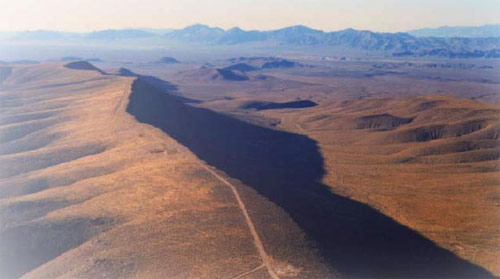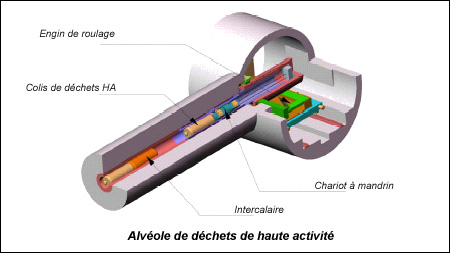Ground-level and deep disposal: a definitive solution
Deep disposal of the most radioactive waste, burying it in deep geological strata, is considered in many countries to be its final destination, the ultimate solution.

Yucca Mountain site
In the US there was a major project to dispose of nuclear reactor waste currently stored around hundred reactors. The chosen location for this disposal site was a mountain in the Nevada Desert, within the perimeter of the US former nuclear testing site, more than 75 miles from Las Vegas. The Yucca Mountain project was approved by President Bush and the Houses, but was abandoned under the Obama administration because of local opposition and criticisms concerning the impermeability of the geological strata.
© DOE
Reversible disposal facilities. Increasingly there are demands for disposal sites to be reversible. This means that, while they are being filled, which can be over a very long period of time, there is still the possibility of removing the packages. Final disposal would be preceded by a lengthy monitoring period when it would be possible to change one’s mind.
Disposal above ground is already practised for the least radioactive waste. There is a low-level waste disposal site on the Cherbourg peninsula in France, which has been filled and is now undergoing a monitoring period. For low-risk materials, the radioactivity of which will be back at the level of natural radioactivity relatively quickly, simple precautions are all that is needed and deep geological disposal does not have to be used.
The same cannot be said for high-activity long-lived waste like spent fuel assemblies or vitrified waste packages. The idea is to dispose of them at great depths in stable geological strata and to place as many obstacles as possible in the way of the migration of the radioactive elements.

Model of a disposal cell
This model of a disposal cell is intented for vitrified high-level waste. Because such wastes givesoff heat, the packages should be separated by spacing buffers to prevent the temperature from rising above 100C in the first hundred years, when the most heat is released.
© CEA
In addition to the obstacles provided by the container and the ‘containment matrix’, there is also an engineered barrier that prevents the package from coming into contact with the rock. First the containers are encapsulated in a very absorbent clay. When it gets wet, this clay (bentonite) swells and acts as a plug. At the end of a monitoring period of around 150 years, it is planned that the site will be closed off (galleries, access shafts and ventilation shafts) by seals also made from an absorbent clay-based substance.
The final barrier is the deep geological stratum. Because the enemy is running water, dry strata are sought (layers of clay, salt mines) in areas with low exposure to seismic risks (faults, volcano eruptions, earthquakes). The probability that these (generally insoluble) radioactive elements will rise up from these depths on to the plate of a consumer is extraordinarily low. The facility is designed and everything is done to prevent this from happening.
No disposal facilities of this kind exist as yet. The first would have been the Yucca Mountain site, where the US would have consigned the waste from its nuclear plants to the drought of the Nevada Desert, 1600 metres down in layers of solidified volcanic ash known as tuff. But this flagship project was abandoned in 2009 after meeting with major opposition, especially local, and running into numerous difficulties.
France has built an underground laboratory in Bure, on the boundary between Haute-Marne and Meuse. The 130 m thick argillaceous layer dating back 155 million years is geologically stable. A ‘transposition zone’ has been defined around the Bure laboratory inside which a site has been chosen. This is Andra’s CIGEO project, which should be approved by parliament in 2015-2016. The construction of a disposal centre can start after that.
These geological strata are a rare resource and one of the objectives of research into radioactive waste is to reduce the amount that ultimately needs to be buried.
To find out more about CIGEO, France’s planned deep geological disposal centre for radioactive waste, click here.
Learn more :
Waste repositories
Geological disposal
CIGEO project
WIPP Project
Prospects for Disposal
Other articles on the subject « Waste strategies »
Slow disappearances
Trapping radioactivity until it disappears A scenario for the long-term future of the waste It wi[...]
Oklo : a natural reactor
Nature at work over the last two billion years It was noticed by chance in the 1970s that a urani[...]
Diluting radioactivity
A practice for elements with low levels of toxicity Management of radioactive waste generally foc[...]
Putting it out of reach
Containment and burial when it is not enough to wait Letting time do its work is not sufficient o[...]
Conditioning
Packages for trapping radioactivity… Conditioning means containing the radioactivity and im[...]
Temporary storages …
Storing: a useful but temporary solution Storing means tidying an object away with the intention [...]
Separating and sorting
Sorting radioactive waste has advantages As with household waste, sorting can prove really useful[...]
Destroy (transmutation)
Transforming radioactive nuclei to make them less troublesome… The incineration of househol[...]
What to transmute?
Transmuting long-lived actinides and fission products Long-lived elements: actinides and fission [...]
Transmuting actinides
Attractive in principle, difficult in practice Destroying actinides using fission reactions is at[...]